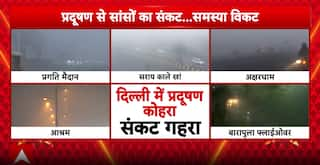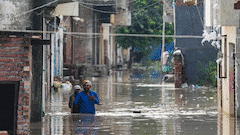WATCH: Thick Layer Of Fog Engulfs Delhi-NCR After Day-Long Rains
People woke up to a thick layer of fog on Thursday morning after rain and thunderstorm lashed parts of Delhi-NCR on Wednesday.

New Delhi: People woke up to a thick layer of fog on Thursday morning after rain and thunderstorm lashed parts of Delhi-NCR on Wednesday.
The Indian Meteorological Department (IMD) has forecasted drizzle at one or two places on Thursday and Saturday in the national capital while the weather will be partly cloudy on Friday and Saturday, IMD said.
A day after heavy rain, the maximum temperature of Delhi settled at 30.6 degrees Celsius, 9 notches below normal on Wednesday. The minimum temperature settled at 20.2 degrees Celsius.
In a video shared by ANI, Delhi roads were seen engulfed by thick fog this morning.
#WATCH| A thick layer of fog enveloped parts of the national capital this morning
— ANI (@ANI) May 4, 2023
(Visuals from Ashram) pic.twitter.com/STnL305c3y
Delhi recorded rainfall up to 20.9 mm in the last 24 hours.
The India Meteorological Department (IMD) on Wednesday issued an alert across Delhi-NCR for the next five days predicting fresh rainfall and hailstorms.
Weather forecast for the next 5 days. pic.twitter.com/pZiVeoLtan
— India Meteorological Department (@Indiametdept) May 3, 2023
According to the IMD, the maximum and minimum temperatures would be around 32 and 17 degrees respectively today in the national capital.
The Safdarjung Observatory (Base observatory) in Delhi has been observing day temperatures settled at least 10 degrees below normal for the last three days due to Western Disturbance-induced rain and cloudy weather.
The maximum temperature settled at 28.7 degrees Celsius on Sunday and dropped to 26.2 degrees Celsius on Monday, making it the second coldest day in the month in 13 years. While on Tuesday, the city recorded a maximum of 28.3 degrees Celsius.
The maximum temperature is predicted to remain below 35 degrees Celsius until May 9.
According to the weather department, May is the hottest month in Delhi with a mean maximum temperature of 39.5 degrees Celsius. However, below-normal maximum temperatures and fewer heatwave days are predicted in northwest India in May.
After a rare triple-dip La Nina, there is a growing probability of the warming of the equatorial Pacific Ocean in the coming months, called the El Nino phenomenon which is associated with higher global temperatures, and it is likely to impact monsoon in India.
La Nina refers to the phase of cooling of the sea-surface temperatures than normal.
The indications of El Nino this year also bring the curtains down on one of the longest-ever La Nina episodes in recorded history -- only the third episode since 1950 to stretch into a third year.
India Meteorological Department (IMD) Director General Mrutyunjay Mohapatra said last week that any effect the El Nino might have on monsoon will only be visible during the second half of the season.
"It is not necessary that an El Nino will lead to a bad monsoon. Of the 15 El Nino years from 1951 to 2022, there were six with normal to above normal rainfall," he had said.
Top Headlines






































